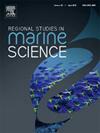有害的藻华对筑坝河口的盐沼池塘的动态有影响
IF 2.4
4区 环境科学与生态学
Q3 ECOLOGY
引用次数: 0
摘要
盐沼塘是滨海湿地的重要组成部分,但对其微藻和有害藻华的研究仍然有限。为了解决这一差距,我们调查了新泽西州羊头草甸半岛smp中微藻的组合和赤潮的发生,研究了三种沼泽类型:开放沼泽、沟渠沼泽和未改变沼泽。在2022年5月至2023年6月期间,每月从六个smp收集样本。各塘微藻组成表现出动态的时间变化和显著的空间异质性。这项研究首次记录了该地区不同沼泽管理制度下中小型湿地中有害藻华的广泛存在。已鉴定的赤潮藻群包括血赤潮鞭毛藻、黄沙amphiidinium carterae、lima原心藻和金色裸子藻、沙下Chattonella Chattonella Akashiwo、小毛藻Prymnesium parvum和蓝藻agardhix plagtothrix aastuarii。在许多情况下,赤潮藻贡献了>; 60 % ~ 98 %的总藻类丰度,鞭毛藻的细胞密度达到103 ~ 104个细胞/mL,小假单胞藻的细胞密度高达105个细胞/mL。水温、盐度、pH和溶解氧等环境变量约占7 %的藻类群落变化,表明其他未测量的因素影响了赤潮的分布。结果表明,封闭和半封闭的池塘可能为赤潮菌的增殖创造有利的微生境。此外,池塘的频繁波动可能促进有害藻华物种的运输,使SMPs成为新泽西州湿地和沿海水域有害藻华的潜在水库。这项研究强调需要将smp纳入长期监测工作,以更好地评估与有害藻华有关的盐沼生境条件和生态健康风险。本文章由计算机程序翻译,如有差异,请以英文原文为准。
Harmful algal blooms contribute to the dynamics of salt marsh ponds in a bar‐built estuary
Salt marsh ponds (SMPs) are a vital component of coastal wetlands, however, studies on microalgae and harmful algal blooms (HABs) in these systems remain limited. To address this gap, we investigated microalgal assemblages and the occurrence of HABs in SMPs on the Sheepshead Meadows Peninsula, New Jersey, across three marsh types: open marsh water managed, ditched, and unaltered. Monthly samples were collected from six SMPs between May 2022 and June 2023. Microalgae composition exhibited dynamic temporal changes in each pond and significant spatial heterogeneity across the ponds. This study is the first to document the widespread presence of HABs in SMPs under different marsh management regimes in this region. Identified HAB taxa included dinoflagellates Akashiwo sanguinea, Amphidinium carterae, Prorocentrum lima and Gymnodinium aureolum, raphidophytes Chattonella subsalsa and Heterosigma akashiwo, haptophyte Prymnesium parvum, and cyanobacteria Planktothrix agardhii, Lyngbya aestuarii. HAB species contributed > 60 % ∼ 98 % of total algal abundance in many cases, with cell densities reaching 103 to 104 cell/mL for dinoflagellates and up to 105 cells/mL for P. parvum. Environmental variables such as water temperature, salinity, pH, and dissolved oxygen accounted for about 7 % of the algal community variance, suggesting other unmeasured factors influence HAB distribution. Our results indicate that the enclosed and semi-enclosed ponds may create favorable microhabitats for HAB proliferation. Additionally, the frequent undulations of the ponds may facilitate the transport of HAB species, making SMPs potential reservoirs for HABs in New Jersey’s wetlands and coastal waters. This study highlights the need to incorporate SMPs into long-term monitoring efforts to better assess salt marsh habitat conditions and ecological health risks associated with HABs.
求助全文
通过发布文献求助,成功后即可免费获取论文全文。
去求助
来源期刊

Regional Studies in Marine Science
Agricultural and Biological Sciences-Ecology, Evolution, Behavior and Systematics
CiteScore
3.90
自引率
4.80%
发文量
336
审稿时长
69 days
期刊介绍:
REGIONAL STUDIES IN MARINE SCIENCE will publish scientifically sound papers on regional aspects of maritime and marine resources in estuaries, coastal zones, continental shelf, the seas and oceans.
 求助内容:
求助内容: 应助结果提醒方式:
应助结果提醒方式:


